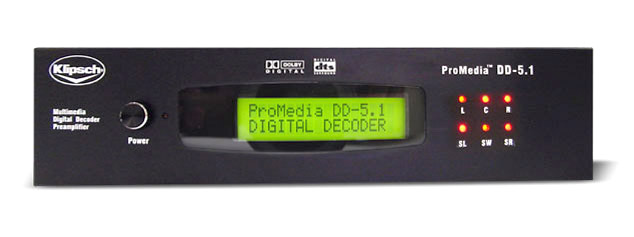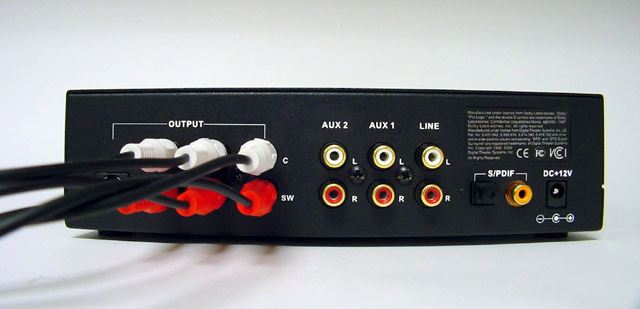
Setting
up the DD-51 Part 1
-Donald1800
-Donald1800

Ok,
guys. Here is the result of analyzing many pages of e-mail info. from
Klipsch on the 'practical' use of the 4 Prologic modes selectable from
the display panel.
1.
ProLogic Disable - Use this setting when
a.
Using digital/optical input with Dolby Digital/DTS encoded media.
b.
Using ANY input and you want only stereo (not even simulated surround)
2.
ProLogic Enable - Use this setting when
a.
Using digital/optical input with ProLogic media, or stereo media and you
want to simulate surround by utilizing naturally recorded delay or reverb.
This setting is overridden if a Dolby Digital/DTS signal is detected,
so this is a safe bet for full time use.
b.
Using analog inputs (Line, Aux1, Aux2) with TV, etc, that transmit programming
in Dolby Surround, or simulating surround sound by utilizing naturally
recorded delay or reverb. This unit does a great job simulating surround
sound with few noticeable artifacts. Again, a safe bet for full time use.
It's
my personal opinion that the following two modes should be ignored.
3.
ProLogic Auto - This mode CAN NOT detect ProLogic from ANY analog input
source (Line, Aux1, Aux2. No 'tagging' or 'flagging'). The only Auto switching
occurres with the digital inputs (coax./Opt.) with ancient and rare material/media
encoded with DD2.0.
4.
All PCM - A redundant limited subset of the 'Enable' mode.
So,
there you have it. A simple selection of 'ProLogic Enable', or ProLogic
Disable'. I've found that 'ProLogic Enable' works great for me 100% of
the time. Enjoy.
Here
is a fast way to estimate the delay for the SL/SR speakers when using
the DD-5.1 decoder that allows this adjustment. Sound travels approx.
1 ft. per millisec (ms). The estimated delay time is the distance in ft.
from the front speakers to your ears, minus the distance in ft. from the
rear speakers to your ears, times 1 ms, rounded to the nearest whole number.
An example, L=14ft R=13ft, R/L avg.=13.5ft SL=6ft SR=5ft, SLSR avg.=5.5ft.
13.5-5.5=8 8X1ms=8ms delay. If you want to be truly accurate, calculate
the left side separately for the SL delay, multiplying by .92ms, then
the right side for SR (X.92ms). Round to the nearest whole number. SL=7ms,
SR=7ms If you want to include the center speaker in your calculations,
its the distance in ft. from the R/L speakers, minus the distance in ft.
from the center speakers times 1ms (.92ms). 13.5-12.5X.92=.92ms, or 1ms.
Thats all folks.
Equalizer
Settings 03-31-2002
Well
folks, this has been a very surprising experiment. It now appears that
my first reported set of EQ settings were in fact done in stereo mode.
Many tests alternating between stereo and ProLogic modes have confirmed
that the first setup was nearly identical to my current STEREO settings.
The surprise concerns the settings required for +/-3db output and Band1=
0db for ProLogic mode. I don't know if it is due to room acoustical effects
(center speaker only in ProLogic mode), ProLogic processing, or both.
There is a larger hole at Band2 (around 250hz) and Band4 (around 8khz)
and a reduction of Subwoofer bass which requires less attenuation at the
Pod SW setting. I will give you three sets of settings - Stereo, ProLogic,
and AVG. which splits the difference between the two, and can be used
under all modes if a single, though inaccurate, setting is desired. Again,
the speakers are mounted slightly above ear level (sitting) on wood paneling
walls with hi-lo wall-to-wall carpet, upholstered couch, love seat and
chair.
STEREO
+/-3db output, Band1= 0db:
Pod
SW= -9db, Band1= 0db, Band2= +3db, Band3= +1db, Band4= +2db, Band5= +10db
ProLogic
+/-3db output, Band1= 0db:
Pod
SW= -3db, Band1= 0db, Band2= +10db, Band3= 0db, Band4= +4db, Band5= +10db
AVG.
Pod
SW= -6db, Band1= 0db, Band2= +7db, Band3= +1db, Band4= +3db, Band5= +10db
Well
guys, I finally dug out from storage my pink noise generator and audio
freq. analyzer to set up the DD-5.1 equalizer with PM 5.1 speakers. I
have them mounted on the wood paneled walls of our living room which has
a hi-lo wall-to-wall carpet, an upholstered couch, love seat and chair,
and thin/shear curtains (no drapes) over the windows. The room is basically
neutral acoustically. I cranked up the volume to 80db SPL and set the
analyzer for C weighting and started the EQ adjustments. The results were
surprising.
[Revised
- These adjustments may have been erroneously made while in the Prologic
Enable mode. Since R/L channels contain the same signal, the decoder strips
the signal and routes it to the center channel ONLY. I will redo after
instrumentation is recharged. This will also indicate speaker placement/room
acoustics effects]
To
realize a flat response with the Pod SW= 0db and a +/- 3db output, use
the following EQ settings: Band1= -9db, Band2= +2db, Band3= +2db, Band4=
0db, Band5= +10db. I personally prefer to set Band1= 0db and set Pod SW=
-9db for flat response, Pod SW= -6db for music, and Pod SW= 0db for DVD's
and XBox games.
I
was not surprised by the high amplitude bass, but I was by the severe
High Freq. rolloff. I asked Klipsch on Monday if this was a result of
using a 'near field' speaker system in a 'far field' application/environment
where the high freq. are spread widely over a 90 deg. pattern, or if this
was a characteristic of the tweeters. I have not received an answer to
this question to date. They evidently feel that these answers are company
classified confidential. Oh well. At least the info. for setting the equalizer
is available to those who have this system but don't have the instrumentation
/knowledge to find out what it needs to be. Try it out. I found the improvement
remarkable, and may eliminate TheEAR's objections to the PM 5.1.
--------------------------------------------------------------------------------
Donald1800:
As
I understand it, the application of the Bass Configuration for Klipsch
speaker systems are as follows:
Bass
Conf. 1 Small speaker mode. Used for other brand speakers with small single
transducers (speakers)
Bass
Conf. 2 2.1 (stereo)
Bass
Conf. 3 4.1
Bass
Conf. 4 5.1
Andy
W (Klipsch tech rep):
#1
is indeed "small" mode for all 5 satellites. In this mode the
DD-5.1 is doing the bass management, like any preamp/processor does, only
that the frequency of the crossover is fixed. The ProMedia 5.1 does it's
own bass management, which is why "large" mode is recommended.
#2
is "large" mains and "small" center and surrounds.
#3
is "large" mains and surrounds and "small" center.
Bass
Config. Off is all satellites in "large" mode.
-->
for the ProMedia 4.1 the recommended setting is "BASS CONFIG. OFF"
(all sats "large") and "SPK C OFF" (using the Cen
button on the remote). Turning off the center speaker mixes the center
channel into the front left and right for a phantom center channel. Also
turn off the sub output ("SPK SW OFF").
-->
for the ProMedia 2.1 the recommended setting is "BASS CONFIG. OFF"
and "SPK C OFF" and "SPK SUR OFF" (using the SL/SR
button on the remote). Turning off the surround speakers mixes the rear
channels into the fronts. Also turn off the sub output ("SPK SW OFF").
--------------------------------------------------------------------------------
Now
from Justin...
Here
is the back of the DD51 for those who do not have one yet.

Browse Hot Topic Help
What's this about RMS?
Manufaturer's spec ratings after Nov. 4, 1974
5.1 Speaker Setup
PowerDVD 4.0 XP
DD-51 Setup
DD-51 Setup Part 2
Getting 5.1 on SBLive 5.1
Getting 5.1 on GTXP 6.1
Getting 5.1 on Audigy
Getting 5.1 on Santa Cruz
Getting 5.1 on Acoustic Edge
Calculate Peaks and Nulls